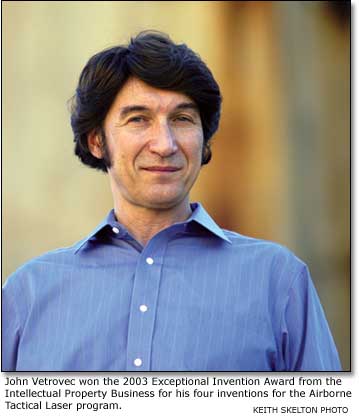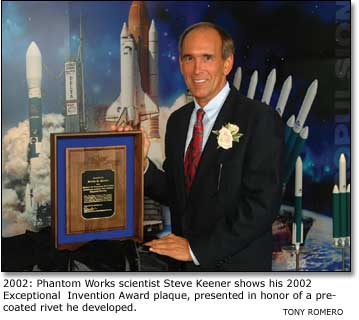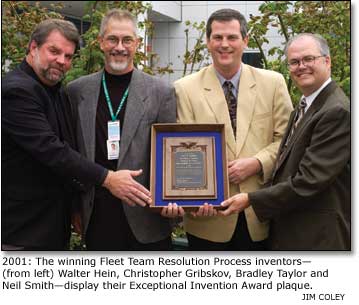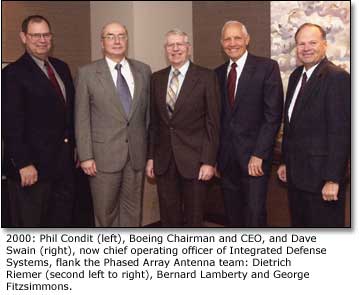| Eureka! Boeing
innovators are using
their exceptional and special
talents to produce inventions
BY JOEL R. NELSON
 To
acknowledge and encourage its engineering and scientific talent,
Boeing has instituted a companywide
Invention Award program that rewards outstanding
innovators. Last year, the program paid $500,000 to the
winners in two categories, Special Invention Awards and
Exceptional Invention Award. To
acknowledge and encourage its engineering and scientific talent,
Boeing has instituted a companywide
Invention Award program that rewards outstanding
innovators. Last year, the program paid $500,000 to the
winners in two categories, Special Invention Awards and
Exceptional Invention Award.
Special Invention Awards are given "for inventions of significant value to the
company"—as technology or process breakthroughs, as products or operations, or
as contributions to company financial success. From this pool of winners and
from those of previous years, a single Exceptional Invention
Award—the top prize for the most innovative minds at
Boeing—is given each year for an invention of "unusual and
outstanding merit."
"The strength of Boeing lies in its diversity of ideas," said
Boeing Chief Technology Officer Jim Jamieson, "and the key to the future is to
make use of the company's incredibly
broad base of knowledge and experience."
This year, Boeing presented Special
Invention Awards to 109 of its inventors for 38 inventions at ceremonies in
Southern California, St. Louis and Seattle. Boeing urges employees
with an innovative
idea or invention to submit it to the Intellectual Property Business accessible
to employees at (http://ip.web.boeing.com/Toolbox.htm).
The winners of the Exceptional Invention Award
represent what might be considered the company Hall of Fame for inventors.
Here are the four employees and teams who have received the award
since its inception
in 2000.
2003: A NEW KIND OF LASER
John Vetrovec's quest to develop more
efficient and compact lasers won him Boeing's top invention recognition
award—and could have a major impact on the way aircraft and even
cars are built, as well as how conflicts are resolved.
While lasers are commonly employed in welding automotive bodies,
their use in aircraft manufacturing is still emerging. Vetrovec said
he believes the technology developed for high-powered military lasers
might one day be used to build
commercial airplanes. "Laser cutting, drilling, and welding have a huge potential
in our industry. Applications will grow rapidly once a laser-weldable aerospace
aluminum alloy is
developed," he said.
Lasers will also offer speed-of-light precision engagement
in the new battlespace, said Vetrovec, whose efforts for the Advanced Tactical
Laser program at Boeing have focused on finding a way to make high-energy lasers
practical for
tactical use. Vetrovec's inventions have overcome two major obstacles: how
to regenerate spent fuel electrochemical cells to make the laser
less dependent on supply logistics, and how
to capture laser gases that previously gave off an exhaust
signature.
Like many inventors, Vetrovec appreciates recognition.
But he said it's the sense of accomplishment his work provides,
the collaboration with other creative scientists and
the encouragement of new innovators that renders the most
reward.
"Persistence and determination are the hallmark of what
we do," he said. "Throughout my career, I've met many skeptics saying that solutions
to certain problems are simply not possible. It's up to us inventors to demonstrate
that anything
is possible."
 2002: C-17 PRECOATED RIVETS 2002: C-17 PRECOATED RIVETS
Steven Keener, a Long Beach, Calif.,
Phantom Works engineer, came up with an idea that's saved millions
of dollars. But his greatest reward came from the shop floor reaction
to his invention. He developed an innovative pre-coated rivet for
the C-17 transport and the Boeing 717 jetliner. The fastener, used
to assemble both metallic and composite materials, eliminated several
steps in the installation and cleanup process. The rivet significantly
improves cycle time and
reduces the risk of galvanic corrosion.
"When I talk with the people using the
new rivet process,
they let me know how it's made a difference," Keener said. "We were able to give
them a better tool, which made them better at what they do. They appreciate that.
It's a feeling of
accomplishment that's tough to duplicate."
Keener's method, for pre-coating aluminum-alloy
components to make them stronger, sparked eight additional patents related
to the methodology, bringing to 16 the total number of patents he
has originated
during his 17 years at Boeing.
 2001: FLEET TEAM RESOLUTION PROCESS 2001: FLEET TEAM RESOLUTION PROCESS
The 2001 Exceptional Invention
Award illustrates the principle that major breakthroughs often
spring from a flash of insight. Searching for data on his 1997 Corvette,
Boeing engineer Walter Hein logged on to an Internet car club and
found what he needed—information drawn from the experiences of numerous
owners and operators. This prompted
an idea. "If I can do this for my car," Hein mused, "why couldn't we do it for
the Boeing commercial airplane fleet?"
With that, Hein and team members Christopher
Gribskov, Neil Smith, and Bradley Taylor created a bulletin-board-style information-sharing
system. It soon replaced the existing—and more labor-intensive—process
for dealing with service-related problems. The Fleet Team Resolution Process
has since become
a way of life for customer fleet chiefs and operators. It has been expanded
since to another Boeing Commercial Airplanes bulletin board process that
deals with
aircraft emerging issues.
 2000: PHASED-ARRAY ANTENNA 2000: PHASED-ARRAY ANTENNA
The first companywide Exceptional Invention
Award was given to George Fitzsimmons, Bernard Lamberty and Dietrich
Riemer for creating the phased-array antenna. This invention helped
to set the standard for outstanding merit. It produced a high-bandwidth
data link that can provide airline passengers with a virtual office
in the sky. Along with Internet connections and e-mail, the new
technology also makes possible audio and video capabilities and a
link to satellite
television. In addition, the phased-array antenna had important
military significance to the Airborne Warning and Control System
and other
reconnaissance aircraft.
Most important, however, it laid the foundation
for an entirely new business unit at Boeing. The phased-array
antenna is the enabling technology behind Connexion by Boeing, permitting
the unit to enter the airline service-provider market. Connexion
by Boeing is potentially a billion-dollar business, and Boeing
Chairman and CEO Phil Condit has identified it as an important
part
of Boeing's
future.
| 
